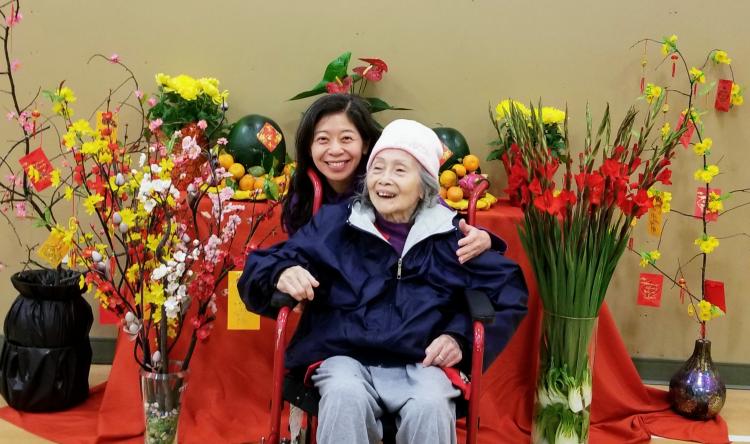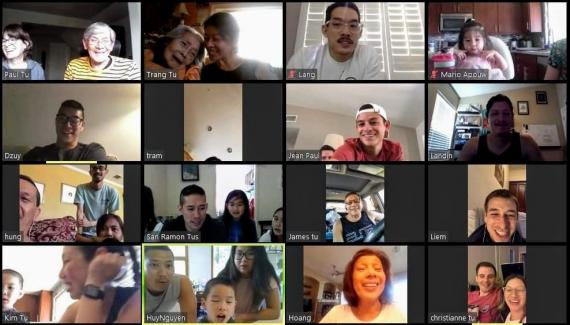By Genevieve Wanucha
Published in Dimensions Magazine - Spring 2021
Among 840,000 unpaid family caregivers in Washington State, there are 353,000 who care for a loved one with Alzheimer’s or another dementia. Among them is Trang Tu, a Vietnamese refugee who immigrated to the U.S. in the 1970s. She is a community organizer and devoted caregiver for her 90-year-old mother, Anna Nguyet Dang. During the pandemic, the restrictions prevented Tu’s out-of-state siblings from visiting to help care for their mother. Without extra help, Tu left her job as a consultant to care for her mother full time and prevent falls or injuries that would require going to the hospital.
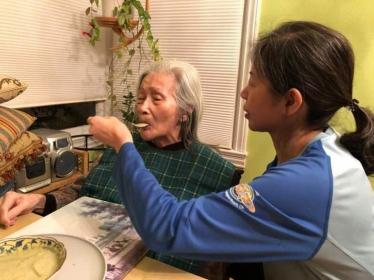
Image courtesy Trang Tu
“I felt like the only way to protect her was going to be a vaccine,” Tu said. She followed along with news on the vaccine development, and especially the plans for vaccine eligibility and distribution. Early in December 2020, the Centers for Disease Control (CDC) issued guidance for states that the first group to receive the vaccine should be long-term care residents and health care workers. There was no mention of elders being cared for at home. Tu searched to find out whether people like her mother would be in the next priority group. All she could find were graphics of vaccine eligibility phases showing adults over 65 not in long-term care.
“Families like ours are going to fall through the cracks,” Tu said. “And, that is when the light bulb went off, and I became alarmed. I was reminded that taking care of our elders at home is more common for a lot of families of color, and refugee and immigrant communities, in particular, based in cultural values or out of financial necessity and lack of culturally appropriate care facilities.”
According to the National Asian Pacific Center on Aging, 42% of Asian American and Pacific Islanders are caregivers, compared with 22% of the general population.
Tu remembers the days leading up to Christmas as a whirlwind of work to advocate on behalf of home caregivers and their loved ones. Having learned last minute that the CDC was holding a virtual Advisory Committee on Immunization Practices meeting on December 20, 2020, Tu quickly wrote up talking points for herself and four of her family members. They had secured limited slots to speak in the one-hour public comment period. During their time, they asked that dependent elders in home care be prioritized in the CDC’s advice to states on vaccine allocation. With their voices heard by national officials and journalists, Tu turned her attention back home, to Washington State.
Reaching out to an initial group of community leaders and advocates, they drafted a letter to the Governor and the State Secretary of Health to call out the invisibility of vulnerable communities in the state’s draft vaccine plan. They highlighted the inequitable access for vulnerable elders, many of whom don’t have the technology, know-how, or language to search for vaccine appointments or register for one. They had only a few days to circulate the letter, but they garnered the support of 87 organizations and 130 individuals who co-signed the petition. This group would continue on and grow as an informal community coalition advocating for vaccine equity in the months to come.
“I wasn’t trying to compete with other groups, but I wanted to make sure that elders being cared for at home are visible,” said Tu. “The home is not the same group setting of a long-term care facility, but there may be just as significant of a risk when you have multi-generational households with people who are essential workers going to high-risk jobs who may also have medically fragile elders in the home. And, since households like these are disproportionately people of color, there is a greater burden that is highly racialized. It all falls at this intersection of systemic inequities.”
The letter worked: the Washington State Department of Health, in its decision making on vaccine rollout, prioritized those over 50 in multi-generational homes who can’t live independently, or are living with and caring for a grandchild.
In January, King County announced an allotment of $7 million to set up two vaccination sites in South King County and assemble mobile vaccination teams for homebound elders. Currently, the Seattle Fire Department’s Mobile Vaccination Teams host daily COVID-19 vaccination events for the most vulnerable community members.
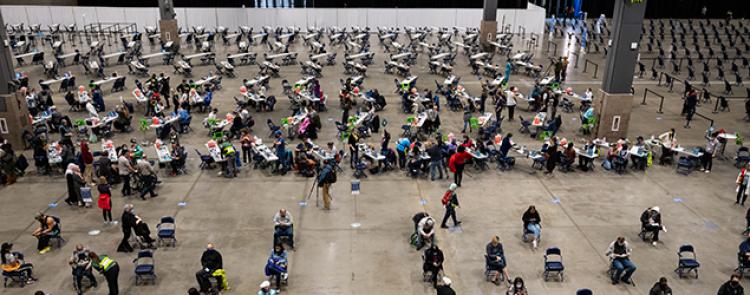
Hundreds of people receive their shots at City of Seattle's Mass Vaccination Site at the Lumen Field Event Center. Credit: Seattle.gov
“We’re grateful for community leaders like Trang who lift up issues to organize our community,” says Michael Byun, Executive Director of Asian Counseling and Referral Service (ACRS). “Her advocacy effort resulted in changes to the state guidance in terms of priority groups. More importantly, the recommendation that she and others put forward highlighted health disparities that are unique to immigrant and refugee families, and the caregivers who support those family members who are vulnerable. This was very much an equity issue that deeply resonated for Asian Counseling and Referral Service. As an organization focused on social justice, we are here to amplify the voices of our community, especially from individuals who are most impacted by the issues at hand.”
Still, immigrant and refugee elders continue to face challenges in accessing the vaccine, reported by families and nonprofits that serve these populations. There are challenges to those especially who cannot understand English or do not have support from an English-speaking caregiver, those without a computer or other technology to look for availabilities or to book appointments, or those who cannot drive or take public transportation to vaccination sites.
Tu and the community collective have deepened their efforts to advocate on behalf of vulnerable elders and caregivers. Volunteers from the group check vaccine sites every day, monitoring and searching for vaccine availabilities throughout Washington state and alerting community organizations at-large who mainly serve Black, Indigenous, and people of color (BIPOC) communities through emails and texts. These non-profits, in turn, assist their clients in getting vaccine appointments.
The community members behind this effort credit Tu’s persistence and determination to bring people together. “I have always believed in the power of numbers, especially when we are coming from a place of racial equity and social justice,” says Samantha Yeun, Program Project Manager at Public Health Seattle & King County, one of the letter co-signers who currently cares for three family members at home.
Another member of this grassroots advocacy community collective is Cuong “TJ” Vu (UW ’22). As a volunteer at the MBWC and ADRC, Vu hopes to gain experience and help those afflicted with memory loss. Vu, a person of Vietnamese heritage, is also motivated by how much Alzheimer’s disease affects the Asian population and other communities disadvantaged by access to care barriers.
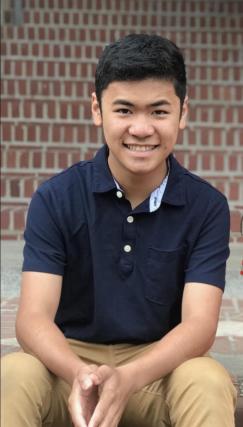
Cuong “TJ” Vu
After seeing how quickly the appointments were taken up from the vaccine notifications via email, Vu thought of the idea to form text groups so that vaccine leads could instantly reach community organizations. As of early April 2021, their text notifications go out multiple times daily. As vaccine eligibility and demand continues to grow, they have also hosted a webinar on vaccine search tips and tricks so that others may also find vaccine availability for BIPOC communities.
“Increased demand only compounds these barriers if we don’t try to level the playing field by assisting our BIPOC elders and those with the greatest barriers to access, especially those with dementia, to provide support in finding vaccine appointments and ensuring equitable access at all vaccination sites,” says Vu. “With increasing vaccine supplies compared to the very beginning when we started out, it is very satisfying and rewarding to see and share numerous vaccination sites, many more available appointments, and mass vaccination events, especially in areas focused around BIPOC communities.”
While a great deal of work remains to render the needs of vulnerable elders and families visible in health systems, Tu is grateful for the response of Washington’s state and local leaders, including Governor Jay Inslee, Secretary of Health Umair A. Shah, King County Executive Dow Constantine, and Seattle Mayor Jenny Durkan and their staff. The advocacy collective also appreciated early support with the state advocacy from U.S. Rep. Pramila Jayapal, as well as state legislators: Rep. Sharon Tomiko Santos, Rep. My-Linh Thai, Rep. Rebecca Saldana, Rep. Debra Entenman, and Sen. Manka Dhingra. •
-Genevieve Wanucha
- Attend and observe vaccination events to see whether they address the barriers our BIPOC communities experience. Are there enough interpreters? Are there signs pointing out where they can get translation assistance? Are the sites near bus routes, or do elders need to walk long distances from the bus stop? Are there informational brochures about the vaccine translated in different languages?
- Train community organizations serving BIPOC communities on how to find vaccine availability.
- Work with city officials to advocate for earlier notification to BIPOC communities or organizations when vaccine availability opens, or reserve BIPOC-only vaccination hours or days. Have walk-in opportunities that don’t require registration or advanced sign-up which is a hardship for many BIPOC elders.
- Ensure interpreters are available at vaccination sites and information is translated in many languages.
